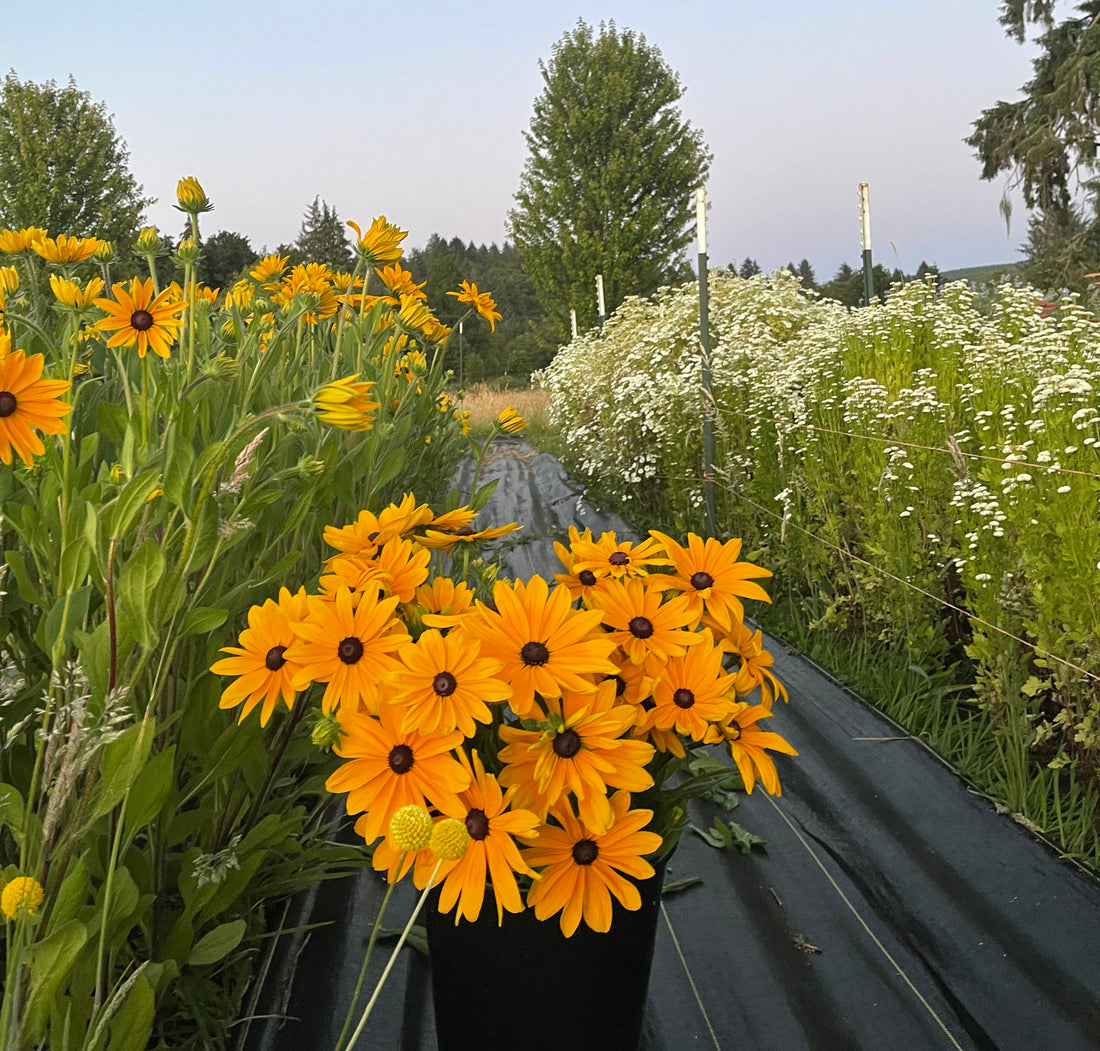Summer is dwindling to an end and it’s time to start planning for fall. Fall is an important time in the garden to prepare for the next season.
If you want to get a head start on the season ahead you should definitely consider planting some flowers in the fall.
Wondering what flowers can be planted in the fall, I got you!
Keep reading…
This blog post will cover:
- How to Calculate Planting Time for YOUR Area
- How to Prepare your Garden Ahead of Time
- How to Protect your flowers through the Winter
- Which flowers can be planted in the fall
- A list of Direct seeded flowers
- A list of Perennials
Which Flowers Can Be Planted in the Fall
There is a special list of Perennials, Biennials, and Hardy Annuals that can be referred to as “Cool Flowers”.
These plants thrive under cooler temperatures and should be planted in the fall, winter or early spring. Planting them early allows them to establish a strong root system and give the earliest blooms in the spring.
In the more northern zones where there are frigid conditions or heavy snow loads, these flowers can be planted in the very early spring (before your last frost date).
Often we can tell which flowers are hardy to cold temperatures by observing nature and seeing which flowers self sow in the garden. Those flowers drop their seeds in the fall, the seeds either sprout immediately and the seedlings overwinter or the seeds stay dormant in the ground and start sprouting in the early spring.
Why should I plant in the fall?
There are many benefits to planting in the fall:
- Less work taking care of the plants throughout the summer (thank you autumn rains!)
- Plants grow more vigorous, have a stronger root system, and taller stems
- Flowers bloom weeks earlier
- Bridge the gap between blooming Spring bulbs and heat-loving annuals
- Some of these plants will not perform well if planted late in the Spring
How to Calculate When to Plant
Fall planting is generally recommended in zones 6+. But some flowers will survive zone 5 as well like Bupleurum, Black-Eyed Susan, Foxgloves, Feverfew, and Canterbury Bells!
If you are in a lower zone, do not worry! You can still get a head-start by planting in the very early Spring - before your last frost. The key is to have your beds prepped ahead of time in the fall so you can dig in. More on that in a bit.
Let’s break down how to calculate your planting time:
- Look up your USDA hardiness zone (https://planthardiness.ars.usda.gov)
- Look up your average First and Last Frost dates (https://www.almanac.com/gardening/frostdates)
- Mark those 2 dates in your calendar.
- As a general rule of thumb you should be planting cool-season flowers 6-8 weeks before the first or last frost date. And you should be starting seeds (for the plants that prefer to be started inside) another 6-8 weeks before planting so you can have suitable-size plants to plant out.
- Count back 8 weeks from both your first and last frost date to find your planting times. Mark those on your calendar.
- Count another 6-8 weeks back from your planting dates for indoor seed starting dates.
Now, I know 6 and 8 weeks is quite the difference and that’s because some seedlings will grow faster and some slower. Some can be planted out smaller and some prefer to be bigger.
Gardening is all about EXPERIMENTING what works for YOU. So don’t be afraid to try a few things out. The seed growing instructions will tell you how long a seed takes to germinate, take that into account when you are counting.
My BIGGEST TIP is to spread your plantings into 2. If you are Fall-planting, save some seeds to plant in the early spring. And if you are spring planting, plant a second succession 4 weeks later. This will allow you to see which flower performs best when and planting in succession extends the bloom time!
How to Prepare your Garden Ahead of Time
In order to be able to plant in the very early Spring while the ground is still frozen or muddy is to prepare your garden beds in the fall.
- Choose a well draining spot in your garden. You don’t want your plants or seeds to get too much water with all the rain or melting snow.
- Clear your beds from their summer flowers as you usually would and amend with compost.
- Cover your beds with mulch and or weed barrier fabric to keep weeds from sprouting and warm the soil until you are ready to plant.
That’s it! When you are ready to plant, remove the weed barrier or move the mulch to plant your seedlings or seeds. If you get heavy snows, the snow, weed barrier and mulch should keep your ground from freezing so you can get those plants tucked in.
Mulch ideas: Grass Clippings, Hay or Straw, Pine Needles, and Leaves. (Make sure the grass has not been treated with any weed killer!)
A black weed barrier will attract more sun and will keep the ground warmer! If you are planting on a larger scale you can use BioFilm 360 (pictured below) or burn holes into weed fabric.

How Protect your Flowers
Plant your seedlings and seeds following the recommended spacing in the growing instructions.
Many of the cool-season flowers will not need any protection and some will do better with a little bit of help.
Floating row cover / frost fabric is your best friend! It’s breathable, comes in different thicknesses and sizes and is easy to find online and at your local hardware store!

Caring for Direct-Sown Plants
- After sowing the seeds cover up with a floating row cover. This will protect the seeds from birds, squirrels, rabbits and deer. And it will create a little microclimate for additional protection from drying winds, the hot sun and will raise the temperature by a few degrees. You can lay the floating row cover flat over the planted area and secure with rocks along the edges.
- Once the seeds have sprouted and are large enough weed thoroughly and thin your seedlings out.
- Do not allow your freshly planted seeds to dry out! The row cover will allow rain and light through but you may need to water if the weather is dry.
Caring for Transplanted Plants
- Harden off your plants for 1 week before planting outside.
- Mulch your beds to help prevent weeds from sprouting. You can plant your seedlings directly into the mulch. Make sure that the mulch you are using hasn’t been treated with any pesticides or weed killers!
- Water after planting and pay close attention for the next 2 weeks to make sure the plants don’t dry out.
- Cover with a floating row cover. You can use metal wire or flexible PVC pipes to create hoops that can be stuck into the ground above the plants.
- Give the baby plants an organic fertilizer to kick off their growing season. I only do that about 2-3 times while they are small.
It’s amazing to see the cool flower garden come alive in the spring. It’s the most rewarding after a long cold winter!
List of 15 Cool-Season Flowers
Bachelor Buttons
Bupleurum
Canterbury Bells (Campanula)
Foxgloves
Feverfew
Echinacea
Nigella (Love-in-a-Mist)
Orlaya
Larkspur
Poppies
Rudbeckia
Snapdragons
Stock
Sweetpeas
Yarrow
Flowers that should be Direct Seeded:
Bachelor Buttons
Bupleurum
Corn Cockle
Echinacea
Larkspur
Love-in-a-Mist (Nigella)
Orlaya
Poppies
Sweet Peas
Perennial Flowers to plant in the Fall:
Echinacea
Feverfew
Rudbeckia
Yarrow


2 comments
Hi Gisela! You can totally do that. The plant will keep growing once transplanted…just as it would if you bumped it up from a small cell tray to a pot or the ground :)
Thank you for the information. If I sow or plant into a nursery bed can I transplant them into their permanent place in the spring or will that defeat the purpose?